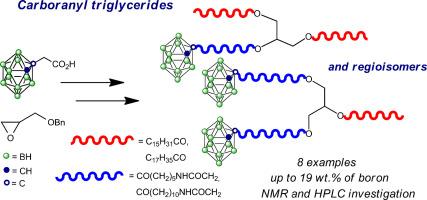Synthesis of carborane-containing glycerides as boron-rich lipid analogues
IF 2.1
3区 化学
Q3 CHEMISTRY, INORGANIC & NUCLEAR
引用次数: 0
Abstract
A method for the synthesis of new glycerol esters containing both one or two 1,2-dicarba-closo-dodecaborane (ortho-carborane) clusters and natural fatty acid (stearic and palmitic) fragments has been developed. Carborane moieties were attached to the glycerol hydroxy groups via ω-amino acid residues. Synthesis of carborane-containing lipid analogues containing up to 19 wt.% boron has been carried out using readily available building blocks. It has been shown that ortho-carborane-containing mono- and diglycerides have a tendency to isomerization as a result of intramolecular migration of the acyl fragment. The isomeric composition was determined by 1H and 13C NMR spectroscopy, as well as by HPLC. The developed preparation method for triglycerides containing 10 or 20 boron atoms per molecule can be used to obtain various carborane-containing lipid analogues. The synthesized compounds are of interest as a potential basis for boron-enriched liposomes and micelles for use in BNCT or PBCT.

含碳硼烷脂质类似物的合成
本文提出了一种合成含有一个或两个1,2-二碳-邻十二硼烷簇和天然脂肪酸(硬脂酸和棕榈酸)片段的新型甘油酯的方法。碳硼烷部分通过ω-氨基酸残基连接到甘油羟基上。含碳硼烷脂质类似物的合成含有高达19 wt.%的硼已经进行了使用现成的积木。已经证明,含邻碳烷的单甘油酯和双甘油酯由于酰基片段的分子内迁移而有异构化的倾向。通过1H、13C NMR和HPLC测定了其异构体的组成。所开发的每分子含有10或20个硼原子的甘油三酯的制备方法可用于获得各种含碳硼烷的脂类类似物。所合成的化合物是用于BNCT或PBCT的富硼脂质体和胶束的潜在基础。
本文章由计算机程序翻译,如有差异,请以英文原文为准。
求助全文
约1分钟内获得全文
求助全文
来源期刊

Journal of Organometallic Chemistry
化学-无机化学与核化学
CiteScore
4.40
自引率
8.70%
发文量
221
审稿时长
36 days
期刊介绍:
The Journal of Organometallic Chemistry targets original papers dealing with theoretical aspects, structural chemistry, synthesis, physical and chemical properties (including reaction mechanisms), and practical applications of organometallic compounds.
Organometallic compounds are defined as compounds that contain metal - carbon bonds. The term metal includes all alkali and alkaline earth metals, all transition metals and the lanthanides and actinides in the Periodic Table. Metalloids including the elements in Group 13 and the heavier members of the Groups 14 - 16 are also included. The term chemistry includes syntheses, characterizations and reaction chemistry of all such compounds. Research reports based on use of organometallic complexes in bioorganometallic chemistry, medicine, material sciences, homogeneous catalysis and energy conversion are also welcome.
The scope of the journal has been enlarged to encompass important research on organometallic complexes in bioorganometallic chemistry and material sciences, and of heavier main group elements in organometallic chemistry. The journal also publishes review articles, short communications and notes.
 求助内容:
求助内容: 应助结果提醒方式:
应助结果提醒方式:


